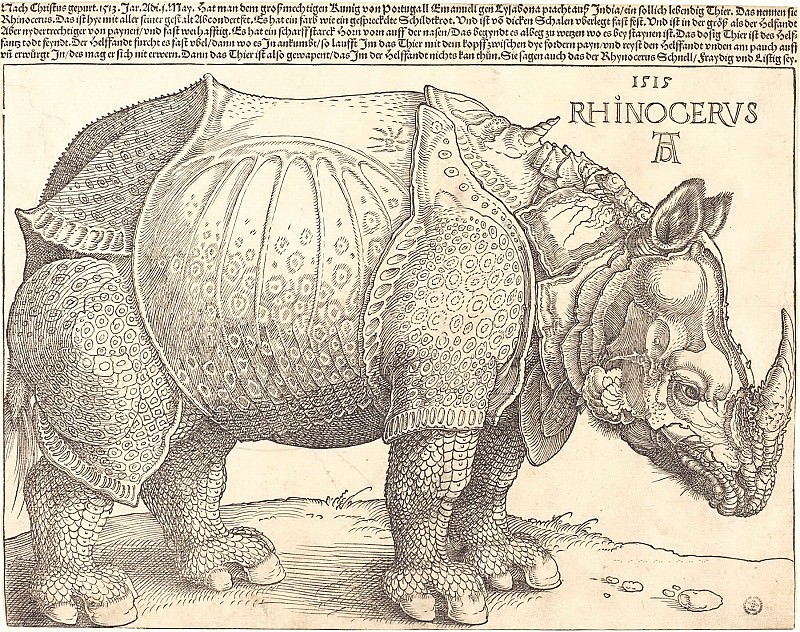Rhino Durer Engravings (1471-1528)
Durer Engravings – Rhino
Edit attribution
Download full size: 1800×1421 px (1,0 Mb)
Painter: Durer Engravings
The engraving is on wood. It was this image that had a tremendous influence on art. Until the 18th century, this image was used in all biology textbooks. Dürer was able to draw the rhinoceros, yet he never saw it in person. At that time in Europe it was believed that this animal existed only in myths. It was synonymous with something incredible. In 1512, the rhinoceros was presented to the Portuguese emperor, who was unspeakably surprised by such an unusual animal.
Description of Albrecht Dürer’s "Rhinoceros" engraving
The engraving is on wood. It was this image that had a tremendous influence on art. Until the 18th century, this image was used in all biology textbooks.
Dürer was able to draw the rhinoceros, yet he never saw it in person. At that time in Europe it was believed that this animal existed only in myths. It was synonymous with something incredible.
In 1512, the rhinoceros was presented to the Portuguese emperor, who was unspeakably surprised by such an unusual animal. The emperor had an overwhelming desire to impress the Pope. He decides to please him with such an unexpected gift and sends the rhinoceros to him. But the animal was transported by ship. The animal went berserk on the way. The rhinoceros made a hole in the ship, and the ship sank. All of Europe began to talk about this unusual beast. Dürer got his hands on a sketch of the rhinoceros made by a man whose name is unknown.
The master was able to depict this incredible animal in a wood engraving. It was Dürer who popularized it. The study of rhinos by his work continued even when Europe was already able to meet this beast in person. This surprised many people.
Dürer endowed the rhinoceros with fabulous features. For example, you can see another horn on its back. It has a shield on the front, and underneath its muzzle are the legendary armor. Some researchers are sure that these armor is not a figment of the artist’s imagination. Before the rhinoceros was presented to the pope, a whole performance was conceived. The rhinoceros was to fight an elephant. It is probable that this was the purpose for which the animal was clothed in this armor. An eyewitness saw it in them and sketched it.
Durer’s creation quickly became really famous. It was sold in a large number of copies. Thus, Salvador Dali created a sculpture depicting this animal.
Durer’s rhinoceros is still fascinating today. Most likely, the secret lies in the wonder that this unusual picture evokes.
Кому понравилось
Пожалуйста, подождите
На эту операцию может потребоваться несколько секунд.
Информация появится в новом окне,
если открытие новых окон не запрещено в настройках вашего браузера.
You need to login
Для работы с коллекциями – пожалуйста, войдите в аккаунт (open in new window).




















You cannot comment Why?
This is a detailed woodcut engraving of a rhinoceros, created by Albrecht Dürer in 1515. The rhinoceros is depicted in profile, facing left, with its head lowered. Its body is heavily armored with overlapping plates, and its legs are thick and scaly, ending in hooves. The texture of the skin is emphasized through intricate linework, giving the impression of a tough, leathery hide. The animal has a prominent horn on its snout and a smaller bump above it, characteristic of the Indian rhinoceros. The background is simple, with a suggestion of ground and a few small pebbles.
Above the animal, there is an inscription in German, with RHINOCERVS and the Roman numerals ISIS (1515) prominently displayed. The text describes the animal, stating it was brought from India and presented to King Manuel I of Portugal. It elaborates on the rhinoceross appearance, its armored skin, its horn, and its perceived aggressive nature. The text also includes some fantastical and inaccurate details, such as the claim that the rhinoceross skin resembles that of a tortoise and that it can fight elephants.
Subtexts: